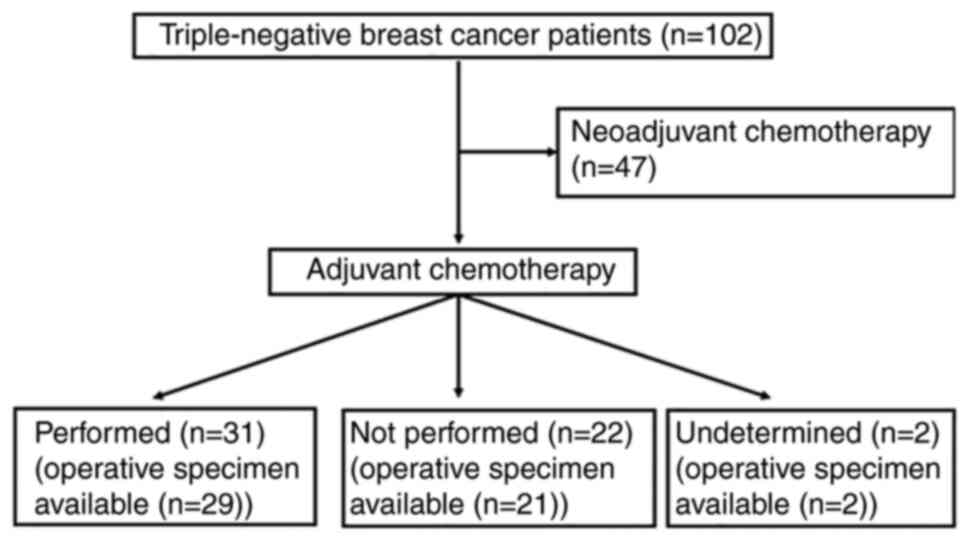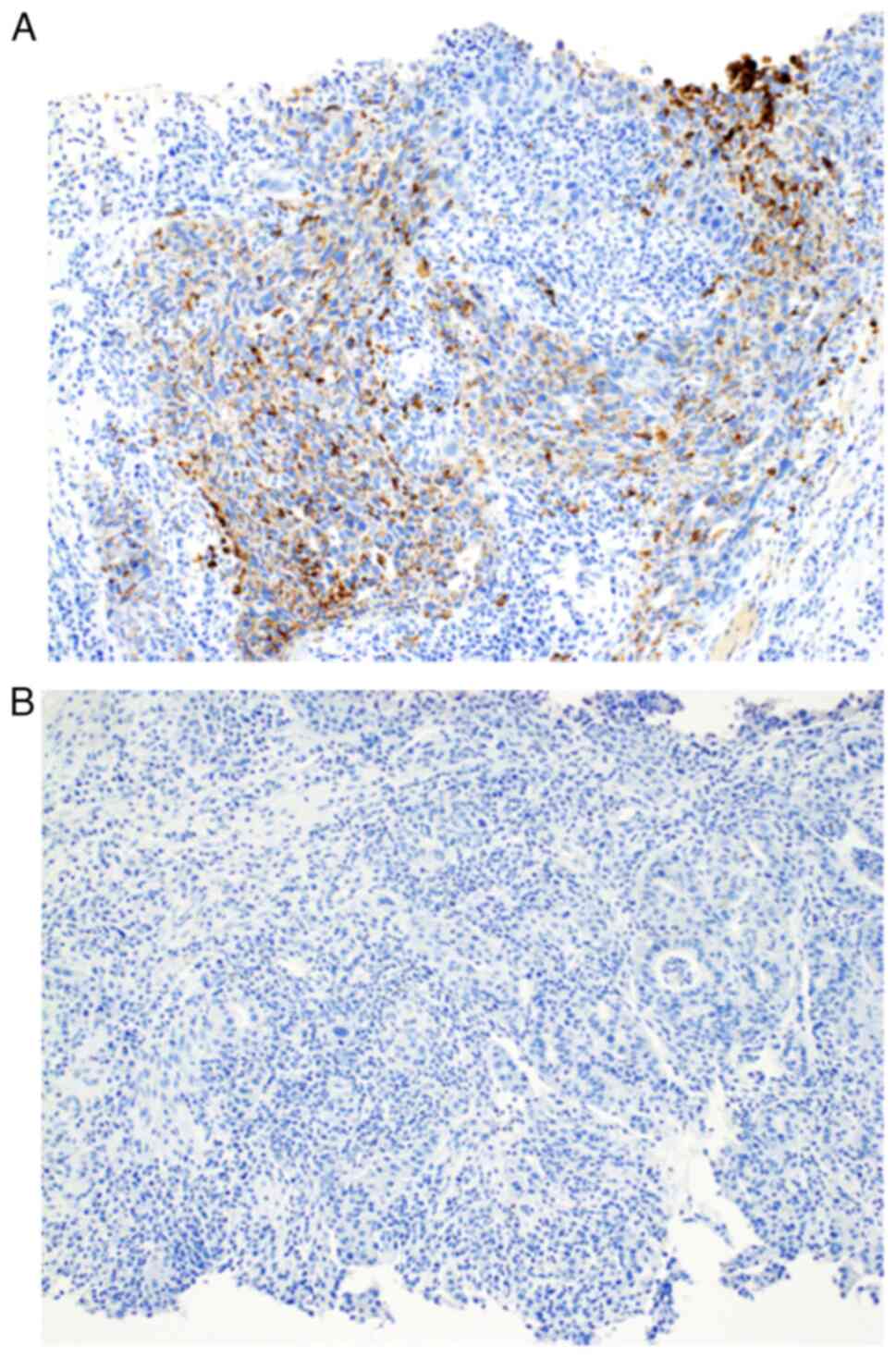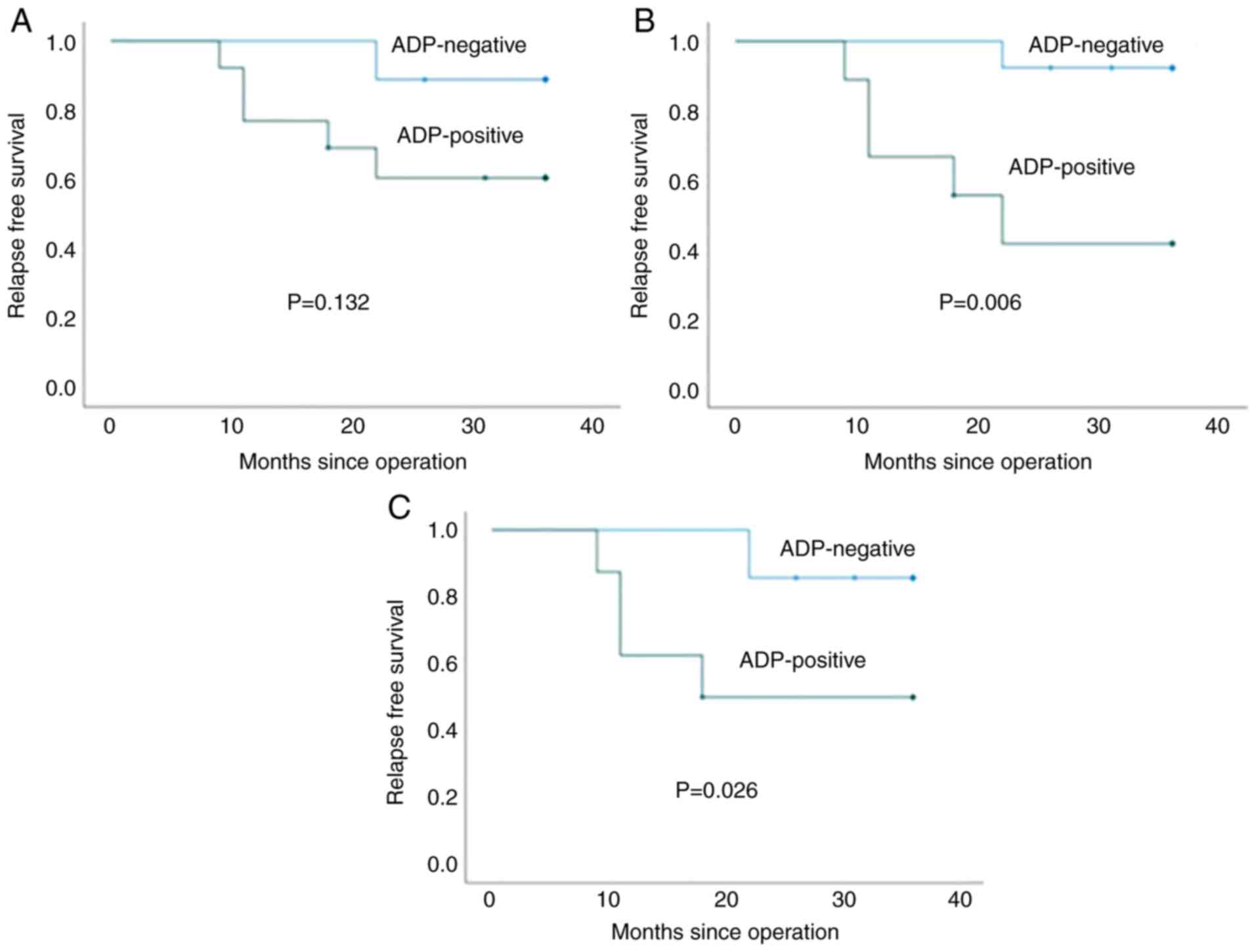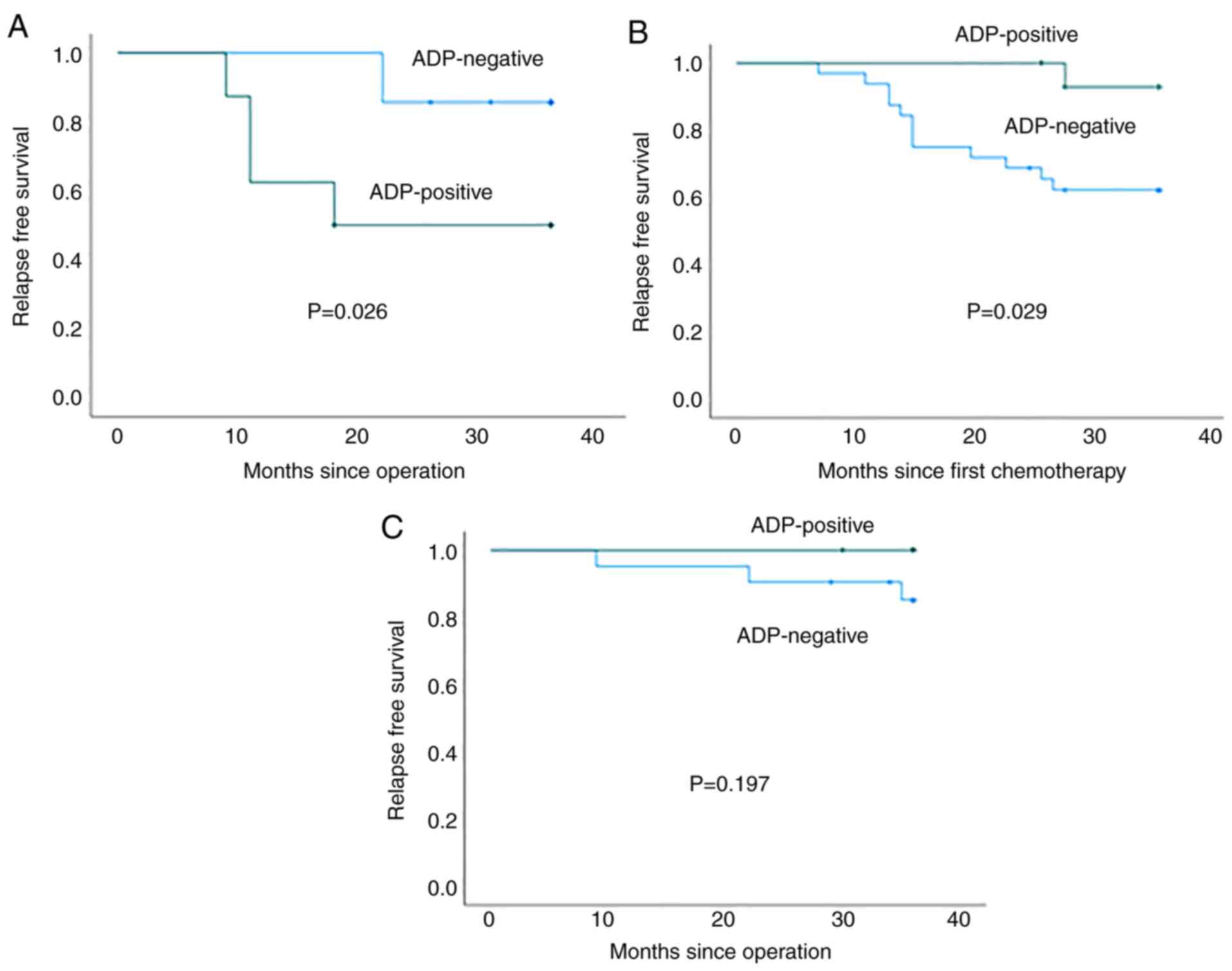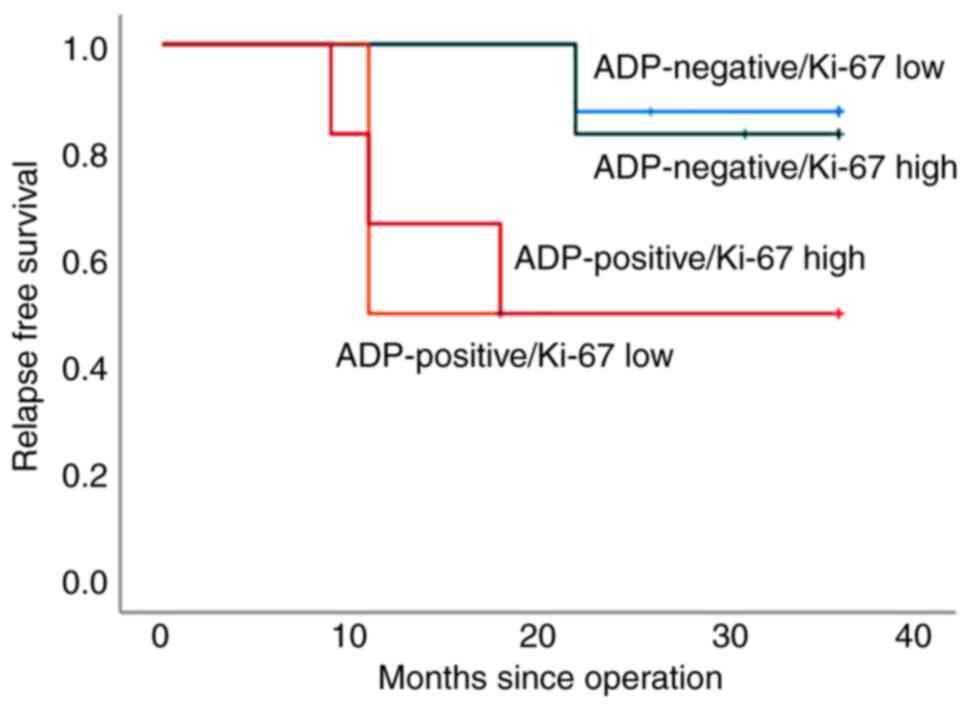Prognostic significance of adipophilin expression in biopsy specimens of patients with triple‑negative breast cancer
- Authors:
- Published online on: February 18, 2022 https://doi.org/10.3892/ol.2022.13247
- Article Number: 127
-
Copyright: © Yoshikawa et al. This is an open access article distributed under the terms of Creative Commons Attribution License.
Abstract
Introduction
Triple-negative breast cancer (TNBC) is the most aggressive subtype of breast cancer and characterized by a lack of expression of estrogen and progesterone receptors and human epidermal growth factor receptor 2 (HER2) (1,2). The Nottingham Prognostic Index, tumor size, Ki-67 labelling index (LI) and lymph node status are recognized as useful prognostic factors; however, these factors are not specific for TNBC (3,4). Thus, a novel prognostic marker for patients with TNBC is needed.
Adipophilin (ADP), also referred to as perilipin 2, is a lipid-associated protein that coats the surface of intracytoplasmic lipid droplets and modulates lipolysis within the cells (5–7). ADP has been reported to be related with some non-neoplastic conditions, such as steatosis of the liver and diabetes (6,8). In addition, several studies show that ADP expression in tumor cells is associated with poor prognosis for some types of carcinomas, including lung (9) and pancreatic ductal adenocarcinomas (10). The present authors recently demonstrated ADP expression as an independent poor prognostic indicator for patients with TNBC (11), with ADP expression in the tumor cells of resected TNBC specimens (defined as >30% of the neoplastic cells) observed in 23.0% of patients with TNBC. In addition, TNBC patients with ADP-positive tumors exhibit poorer relapse-free survival (RFS) as compared with those with ADP-negative tumors, with multivariate analysis revealing ADP as an independent poor prognostic marker (11).
Initial treatment plans for patients with breast cancer are typically decided based on the analysis of biopsy specimens. As the results are derived from operative specimens of patients with TNBC, the prognostic significance of ADP expression in biopsy specimens and the relationship of ADP expression between operative and biopsy specimens must be clarified. The aim of the present study was to analyze the prognostic significance of ADP expression using preoperative biopsy specimens from patients with TNBC and to compare the ADP-expression status between biopsy and operative specimens.
Materials and methods
Patient selection
The present study selected 165 consecutive patients with TNBC who underwent surgical resection at the Department of Surgery of Kansai Medical University Hospital between January 2006 and December 2018. Patients diagnosed with invasive breast carcinoma of no special type according to the recent World Health Organization Classification of Breast Tumors (12) were selected. Patients for whom biopsy specimens were unavailable were excluded from the study. In addition, patients with a special type of invasive carcinoma were excluded from the present study, as each special type of carcinoma has unique clinicopathological features. Ultimately, 102 patients with TNBC were included in the present study. The patient cohort overlapped with those of our previous studies (11,13,14). The prognostic significance of ADP expression was previously analyzed in tissue microarrays using operative specimens from patients with TNBC (11). The present study included information from our previous study regarding the ADP-expression status of operative specimens (11). Additionally, the authors previously examined the relationship between clinicopathological features and PD-L1-positive cancer-associated fibroblasts (13) and the immune-checkpoint protein CD155 (14) in patients with TNBC using tissue microarrays of operative specimens. However, the content of the present study does not overlap with that of the previous two studies.
This retrospective single-institution study was conducted in accordance with the principles of the Declaration of Helsinki and the study protocol was approved by the Institutional Review Board of Kansai Medical University Hospital (approval no. 2019234). Informed consent was obtained from patients using the opt-out method because of the retrospective design of the study and because there was no risk to the participants. In addition, the present study does not include minors. Information regarding this study, such as the inclusion criteria and opportunity to opt out, is provided on the institutional website (kmu.ac.jp/hirakata/hospital/2671t800000136cd-att/a1582783269511.pdf).
Histopathologic analysis
Surgically resected and biopsy specimens were fixed with 10% formalin at room temperature (24–48 h), sectioned, dehydrated by ethanol and xylene at room temperature, embedded in paraffin (60°C), and stained with hematoxylin and eosin (5 min each) at room temperature. All histopathological diagnoses were independently evaluated by more than two experienced diagnostic pathologists. The TNM Classification of Malignant Tumors (8th edition; legeforeningen.no/contentassets/201604933ce448e888a101ab969a4205/tnm-classification-of-malignant-tumours-8th-edition.pdf) was used and histopathological grading was based on the Nottingham histological grade (15). According to a meta-analysis of patients with TNBC, the Ki-67 LI was considered high at ≥40% (16). The response following neoadjuvant chemotherapy (NAC) was assessed based on the Miller-Payne grading system established by Ogston et al (17).
Tissue microarray
Hematoxylin and eosin-stained slides were evaluated to select regions of the resected specimens that were most morphologically representative of carcinoma. A total of three tissue cores with diameters of 2 mm were punched out from the paraffin-embedded blocks for each patient. The tissue cores were then arrayed in recipient paraffin blocks for analysis. These specimens were also used in our previous studies (11,13,14).
Immunohistochemistry
Immunohistochemical analyses were performed using a Discovery ULTRA automated immunohistochemistry staining system (Roche Diagnostics). A mouse monoclonal antibody against ADP (1:100; cat. no. AP125; Progen Biotechnik GmbH) was used as the primary antibody. Human sebaceous gland tissues were used as positive controls for ADP staining. All biopsy specimens and tumor microarrays were evaluated for ADP levels. At least two researchers independently evaluated the immunohistochemical staining results. These procedures were similar to those previously described (11). To determine the cut-off value for ADP expression, analyses were performed using positive cut-off values of 1, 5, 10, 20 and 30%.
Statistical analyses
All analyses were performed using SPSS software (v.27.0; IBM Corp.). Correlations between two groups were determined using Fisher's exact test for categorical variables and the Mann-Whitney U test for continuous variables. RFS was evaluated using Kaplan-Meier analysis and log-rank tests were used to compare the two groups. The Cox proportional hazards model was used to examine the correlation between clinicopathological parameters and survival. Statistical significance was set at P≤0.05.
Results
Clinicopathological features
The present study included 102 women with TNBC. Table I summarizes the clinicopathological features of the study cohort. The median age at the time of initial diagnosis was 63 years (range: 31–93 years). All patients were diagnosed with TNBC based on biopsy results and all tumors were invasive carcinomas of no special type. The median clinical tumor diameter was 20 mm (range: 0–100 mm). Two patients were initially diagnosed with ductal carcinoma in situ (non-invasive ductal carcinoma); thus, the cohort included a clinical tumor diameter of 0 mm. Patients were clinically staged as 0 (2 patients), I (41 patients), IIA (28 patients), IIB (23 patients), IIIA (3 patients), IIIB (4 patients) and IIIC (1 patient). A total of 21 patients (20.6%) experienced relapse involving distant metastasis and none experienced local recurrence.
As shown in Table I, NAC was administered to 47 patients (46.1%) and adjuvant chemotherapy to 31 patients (30.4%). No NAC or adjuvant chemotherapy was administered to 22 patients (21.6%). An overview of the study cohort is summarized in Fig. 1 and subclassification of the clinicopathological characteristics of the NAC and non-NAC groups is shown in Table II. Tumor size and lymph node status were clinically evaluated in the NAC group and pathologically evaluated in the non-NAC group.
Table II.Subclassification of clinical characteristics of patients with triple-negative breast cancer. |
Chemotherapy regimens were selected based on the treatment criteria (Table I). All patients in the NAC group and 22 patients (71%) in the adjuvant chemotherapy group were administered sequential anthracycline-based and taxane-based regimens. A total of three patients in the adjuvant chemotherapy group (10%) were administered only anthracycline-based regimens and six patients in the adjuvant chemotherapy group (19%) were administered oral fluoropyridine therapy. The anthracycline-based regimens included EC (epirubicin, 100 mg/m2; and cyclophosphamide, 500 mg/m2), AC (doxorubicin, 60 mg/m2; and cyclophosphamide, 600 mg/m2) and FEC (epirubicin, 100 mg/m2; cyclophosphamide, 500 mg/m2; and 5-fluorouracil, 500 mg/m2). Chemotherapy was administered every 2 to 3 weeks for four cycles. Taxane-based regimens included docetaxel at a dose of 70 mg/m2 every 3 weeks for four cycles or paclitaxel at a weekly dose of 80 mg/m2 for 12 doses with scheduled rest. Fluoropyrimidine regimens included oral uracil-tegafur (300 mg/m2) daily for 2 years and oral S-1 (100 mg/day) on a 21-day cycle of 14 consecutive days dosing with 7 days off, which was repeated for 1 year.
Correlation between ADP expression in biopsy specimens and postoperative RFS in patients without NAC or adjuvant chemotherapy
Typical positive and negative immunohistochemical staining of biopsy specimens for ADP are shown in Fig. 2. To evaluate the optimal cut-off value of ADP expression in the biopsy specimens, the relationship between ADP-expression values and RFS in patients who were not administered NAC or adjuvant chemotherapy was analyzed. Cut-off values of 5, 10, 20 and 30% were significantly associated with RFS (P=0.006, 0.006, 0.006 and 0.026, respectively), whereas a cut-off value of 1% was not significantly associated with RFS (P=0.132; Fig. 3). Based on these findings and because the cut-off value for operative specimens in our previous study was set at 30% (11), a cut-off value of 30% was used for subsequent analyses.
Correlation between clinicopathological factors and ADP expression in biopsy specimens
The correlation between clinicopathological factors and ADP expression in biopsy specimens (cut-off value: 30%) is summarized in Table III. Among the entire cohort, including the NAC and non-NAC groups, ADP expression was observed in biopsy specimens from 35.3% of patients (36/102), whereas biopsy specimens from the remaining 64.7% of patients (66/102) were ADP-negative. The presence of lymph node metastasis based on clinical evaluation was significantly higher in ADP-negative patients compared with that in ADP-positive patients (P=0.031) and a high Ki-67 LI was associated with ADP-positivity (P<0.001). However, tumor size and clinical stage were not significantly associated with ADP expression.
ADP expression was observed in 34% (16/47) of patients in the NAC group and 36.4% (20/55) of patients in the non-NAC group (Tables IV and V). In the NAC group, ADP expression was significantly associated with the clinically evaluated absence of lymph node metastasis (P=0.007) and high Ki-67 LI (P=0.004) but not with tumor size, clinical stage, or the effect of NAC (Miller-Payne grading). In the non-NAC group, ADP expression was significantly associated with histological grade (P=0.026) and a high Ki-67 LI (P=0.019) but not with pathologically evaluated lymph node metastasis or tumor size. In the early stage of disease for patients with TNBC (clinical or pathological stages 0, I, or II), ADP expression was significantly associated with absence of lymph node metastasis by clinical assessment in all patient groups (P=0.022; Table VI). This trend was also observed in the NAC group (P=0.005) but not in the non-NAC group (P=0.759).
Table IV.Correlation between clinicopathological factors (NAC group) and ADP expression in biopsy specimens . |
Table V.Correlation between clinicopathological factors (non-NAC group) and ADP expression in biopsy specimens. |
Association of ADP expression in biopsy specimens and postoperative RFS
Fig. 4 shows the RFS curves for ADP-positive and -negative patients. As described, ADP expression in biopsy specimens was significantly associated with a poor RFS in patients who were not administered NAC or adjuvant chemotherapy (P=0.026; Fig. 4A). By contrast, the RFS of ADP-negative patients was significantly poorer as compared with that of ADP-positive patients in the NAC group (P=0.029; Fig. 4B). ADP expression was not significantly associated with the RFS of patients administered adjuvant chemotherapy (P=0.197; Fig. 4C).
Fig. 5 shows the RFS curves of ADP expression and Ki-67 LI for biopsy specimens of patients who were not administered NAC or adjuvant chemotherapy. There was no difference in RFS between patients with high and low Ki-67 LI values among both ADP-negative and -positive patients (P=0.832 and P=0.979, respectively).
Prognostic potential of ADP expression in biopsy specimens from patients without NAC or adjuvant chemotherapy
Univariate analysis was then performed to determine the association between clinicopathological factors and RFS in patients who were not treated with NAC or adjuvant chemotherapy (Table VII). Only ADP expression was significantly associated with a poor RFS (hazard ratio, 5.630; 95% confidence interval, 1–31.72; P=0.05), whereas tumor size, lymph node status, Ki-67 LI and histological grade were not.
Correlation of ADP expression in biopsy and operative specimens
Not including the operative specimens from patients treated with NAC, both biopsy and operative specimens were available for 52 patients in the current study cohort. This included 29 patients who had been treated with adjuvant chemotherapy, 21 patients without adjuvant chemotherapy and two patients for whom the performance of adjuvant chemotherapy was not determined (Fig. 1). Table VII shows the correlation of ADP expression in biopsy and operative specimens according to a cut-off value of 30% for expression. The concordance rate was 73.1% and Cohen's kappa coefficient was 0.385, indicating fair agreement (P=0.003).
Discussion
The present study clearly demonstrated that ADP expression in biopsy specimens was a poor prognostic factor in patients with TNBC and consistent with its expression in operative specimens (11). Using an optimal cut-off value of 30%, ADP expression in biopsy specimens was significantly associated with higher Ki-67 LI. Finally, fair agreement was observed in ADP expression between biopsy and surgical specimens.
Biopsy specimens provide critical information for deciding the treatment strategy for patients with breast cancer, including the expression status of hormone receptors and HER2. Furthermore, histological grade and Ki-67 LI are well-known prognostic indicators (3,4); however, these indicators are not specific for TNBC. Using immunohistochemical staining and operative specimens of TNBC, the present authors previously demonstrated that ADP expression is an independent poor prognostic factor in patients with TNBC (9). The present study examined the prognostic role of ADP expression in preoperative biopsy specimens of patients with TNBC. First, the optimal cut-off value of ADP expression in biopsy specimens was determined by analyzing the relationship between ADP expression and RFS in patients who had not been treated with NAC or adjuvant chemotherapy. These patients were chosen because they were not influenced by chemotherapy and would likely demonstrate the direct effect of ADP expression. Cut-off values of 5, 10, 20 and 30% were significantly associated with RFS. The cut-off value of ADP expression was set at 30% for subsequent analyses, as it was significantly associated with RFS and used as the cut-off value in our previous study evaluating operative specimens of TNBC (11). In general, a cut-off value of 30% ADP expression can be used to predict the RFS of patients with TNBC using either biopsy or operative specimens. Other studies showed ADP expression as a significant poor prognostic indicator in some types of carcinomas, including lung adenocarcinoma (9) and pancreatic ductal adenocarcinoma (10). However, these results were derived using only operative specimens from carcinomas (9,10). Therefore, the present study was the first to analyze the prognostic significance of ADP expression in biopsy specimens. In addition, the cut-off value of ADP expression might differ among the several types of carcinoma. For instance, in lung adenocarcinoma (9) and pancreatic ductal adenocarcinoma (10) it was set at 5%.
The prognostic significance of ADP expression was subsequently analyzed in biopsy specimens of patients with TNBC treated with NAC or adjuvant chemotherapy. Interestingly, ADP expression was a significantly worse indicator of RFS in patients who did not receive NAC or adjuvant chemotherapy. However, among the NAC group, ADP-positive patients showed a significantly better RFS compared with ADP-negative patients. ADP expression was not a significant factor in patients administered adjuvant chemotherapy. These results suggested that ADP-positive patients exhibit better chemotherapy responsiveness as compared with ADP-negative patients; however, the histological NAC effect (Miller-Payne grading) did not differ significantly between ADP-positive and -negative patients. This may have been related to the fact that Ki-67 LI in the current study cohort was significantly higher in ADP-positive patients compared with ADP-negative patients. This trend was also observed in another report on breast cancer (18). It was hypothesized that NAC could control ADP-positive highly proliferative carcinoma cells to some degree, but some of these cells might show chemoresistance. These carcinoma cells showing chemoresistance might influence the effect of adjuvant chemotherapy. Additional studies are needed to clarify the relationship between ADP expression and chemotherapeutic effectiveness.
Notably, neither a low nor high Ki-67 LI significantly associated with RFS among ADP-positive or -negative patients who were not administered NAC or adjuvant chemotherapy. This indicated that ADP is a superior prognostic marker as compared with Ki-67LI in patients with TNBC (11) and a result consistent with ADP expression in operative specimens from patients with TNBC. Accordingly, ADP expression in both biopsy and operative specimens may be a superior prognostic marker in patients with TNBC.
As discussed in our previous study (11), the mechanism of ADP expression in TNBC leading to poor prognosis remains to be elucidated. ADP expression in TNBC reflects the upregulation of lipid metabolism and lipid synthesis is associated with TNBC growth (19). As Ki-67 LI was significantly higher in ADP-positive patients in the cohort of the present study as compared with that in ADP-negative patients [a finding consistent with a previous study (18)], ADP expression was associated with higher proliferative activity of TNBC neoplastic cells. Intracytoplasmic metabolism, including lipid metabolism and amino acid metabolism, may differ in ADP-positive TNBC as compared with ADP-negative TNBC. Additional studies are needed to clarify the mechanism of ADP expression in TNBC and determine the metabolic differences between ADP-positive and -negative TNBC.
There are several limitations to the present study. First, this was a retrospective, single-institute study. Although it evaluated >100 patients with TNBC, the subgroups, such as patients who had not been treated with NAC or adjuvant chemotherapy, were relatively small, which may have led to selection bias. Therefore, additional studies of a large number of patients with TNBC must be performed to verify the prognostic significance of ADP expression in patients with TNBC with or without NAC or adjuvant chemotherapy. Second, the results demonstrated that ADP expression was significantly associated with the clinically evaluated absence of lymph node metastasis in the entire cohort and the NAC subgroup. Lymph node metastasis was evaluated clinically because NAC influences the status of lymph node metastasis. Although ADP expression in the biopsy specimens was a significant poor prognostic marker, lymph node metastasis is considered to be a poor prognostic factor. Thus, ADP expression in the biopsy specimens might be a more useful marker compared with the clinically evaluated lymph node status because the evaluation of the presence of lymph node metastasis can depend on the observer. Third, the prognostic significance of ADP expression in both biopsy and operative specimens for patients with hormone receptor-positive or HER2-positive breast cancer remains unresolved and requires further analysis.
In conclusion, these results clearly demonstrated that ADP expression in biopsy specimens is a poor prognostic factor in patients with TNBC. Furthermore, ADP expression in biopsy specimens was significantly associated with a higher Ki-67 LI and might be associated with chemotherapeutic effectiveness. Accordingly, additional studies are needed to establish new preoperative treatment strategies, including the evaluation of ADP expression in biopsy specimens.
Acknowledgements
Not applicable.
Funding
This study was supported in part by AMED (grant no. JP21lm0203006 to MI), the Osaka Community Foundation 2020 (to MI) and research grants D1 (to MI) and D2 (to KY) from Kansai Medical University.
Availability of data and materials
All data generated and analyzed in this study are included in this published article.
Authors' contributions
KY and MI were responsible for the conception and design of the study. KY and MI performed immunohistochemical analyses. KY, MI, HY, KT, MS and TS performed acquisition and analysis of data. KY and MI confirm the authenticity of all the raw data and KY and MI drafted the manuscript, tables and figures. All authors reviewed and approved the final manuscript.
Ethics approval and consent to participate
This study was conducted in accordance with the Declaration of Helsinki and the study protocol was approved by the institutional review board of the Kansai Medical University Hospital (protocol no. 2019234).
Consent for publication
The need for informed consent was waived because of the retrospective design of the study.
Competing interests
The authors declare that they have no competing interests.
References
|
Cleator S, Heller W and Coombes RC: Triple-negative breast cancer: Therapeutic options. Lancet Oncol. 8:235–244. 2007. View Article : Google Scholar : PubMed/NCBI | |
|
Dent R, Trudeau M, Pritchard KI, Hanna WM, Kahn HK, Sawka CA, Lickley LA, Rawlinson E, Sun P and Narod SA: Triple-negative breast cancer: Clinical features and patterns of recurrence. Clin Cancer Res. 13:4429–4434. 2007. View Article : Google Scholar : PubMed/NCBI | |
|
Rakha EA, El-Sayed ME, Green AR, Lee AH, Robertson JF and Ellis IO: Prognostic markers in triple-negative breast cancer. Cancer. 109:25–32. 2007. View Article : Google Scholar : PubMed/NCBI | |
|
Keam B, Im SA, Lee KH, Han SW, Oh DY, Kim JH, Lee SH, Han W, Kim DW, Kim TY, et al: Ki-67 can be used for further classification of triple negative breast cancer into two subtypes with different response and prognosis. Breast Cancer Res. 13:R222011. View Article : Google Scholar : PubMed/NCBI | |
|
Bickel PE, Tansey JT and Welte MA: PAT proteins, an ancient family of lipid droplet proteins that regulate cellular lipid stores. Biochim Biophys Acta. 1791:419–440. 2009. View Article : Google Scholar : PubMed/NCBI | |
|
Sztalryd C and Kimmel AR: Perilipins: Lipid droplet coat proteins adapted for tissue-specific energy storage and utilization, and lipid cytoprotection. Biochimie. 96:96–101. 2014. View Article : Google Scholar : PubMed/NCBI | |
|
Sztalryd C and Brasaemle DL: The perilipin family of lipid droplet proteins: Gatekeepers of intracellular lipolysis. Biochim Biophys Acta Mol Cell Biol Lipids. 1862:1221–1232. 2017. View Article : Google Scholar : PubMed/NCBI | |
|
Nitulescu GM, Van De Venter M, Nitulescu G, Ungurianu A, Juzenas P, Peng Q, Olaru OT, Grădinaru D, Tsatsakis A, Tsoukalas D, et al: The Akt pathway in oncology therapy and beyond (Review). Int J Oncol. 53:2319–2331. 2018.PubMed/NCBI | |
|
Fujimoto M, Yoshizawa A, Sumiyoshi S, Sonobe M, Menju T, Hirata M, Momose M, Date H and Haga H: Adipophilin expression in lung adenocarcinoma is associated with apocrine-like features and poor clinical prognosis: An immunohistochemical study of 328 cases. Histopathology. 70:232–241. 2017. View Article : Google Scholar : PubMed/NCBI | |
|
Hashimoto Y, Ishida M, Ryota H, Yamamoto T, Kosaka H, Hirooka S, Yamaki S, Kotsuka M, Matsui Y, Yanagimoto H, et al: Adipophilin expression is an indicator of poor prognosis in patients with pancreatic ductal adenocarcinoma: An immunohistochemical analysis. Pancreatology. 19:443–448. 2019. View Article : Google Scholar : PubMed/NCBI | |
|
Yoshikawa K, Ishida M, Yanai H, Tsuta K, Sekimoto M and Sugie T: Adipophilin expression is an independent marker for poor prognosis of patients with triple-negative breast cancer: An immunohistochemical study. PLoS One. 15:e02425632020. View Article : Google Scholar : PubMed/NCBI | |
|
Rakha EA, Allison KH, Bu H, Ellis IO, Foschini MP, Horii R, et al: Invasive breast carcinoma of no special type. WHO Classification of Tumours. 5th edition. Breast Tumours IARC; Lyon: pp. 102–109. 2019 | |
|
Yoshikawa K, Ishida M, Yanai H, Tsuta K, Sekimoto M and Sugie T: Prognostic significance of PD-L1-positive cancer-associated fibroblasts in patients with triple-negative breast cancer. BMC Cancer. 21:2392021. View Article : Google Scholar : PubMed/NCBI | |
|
Yoshikawa K, Ishida M, Yanai H, Tsuta K, Sekimoto M and Sugie T: Immunohistochemical analysis of CD155 expression in triple-negative breast cancer patients. PLoS One. 16:e02531762021. View Article : Google Scholar : PubMed/NCBI | |
|
Elston CW and Ellis IO: Pathological prognostic factors in breast cancer. I. The value of histological grade in breast cancer: Experience from a large study with long-term follow-up. Histopathology. 19:403–410. 1991. View Article : Google Scholar : PubMed/NCBI | |
|
Wu Q, Ma G, Deng Y, Luo W, Zhao Y, Li W and Zhou Q: Prognostic value of Ki-67 in patients with resected triple-negative breast cancer: A meta-analysis. Front Oncol. 9:10682019. View Article : Google Scholar : PubMed/NCBI | |
|
Ogston KN, Miller ID, Payne S, Hutcheon AW, Sarkar TK, Smith I, Schofield A and Heys SD: A new histological grading system to assess response of breast cancers to primary chemotherapy: Prognostic significance and survival. Breast. 12:320–327. 2003. View Article : Google Scholar : PubMed/NCBI | |
|
Kuniyoshi S, Miki Y, Sasaki A, Iwabuchi E, Ono K, Onodera Y, Hirakawa H, Ishida T, Yoshimi N and Sasano H: The significance of lipid accumulation in breast carcinoma cells through perilipin 2 and its clinicopathological significance. Pathol Int. 69:463–471. 2019. View Article : Google Scholar : PubMed/NCBI | |
|
Pucer A, Brglez V, Payré C, Pungerčar J, Lambeau G and Petan T: Group X secreted phospholipase A(2) induces lipid droplet formation and prolongs breast cancer cell survival. Mol Cancer. 12:1112013. View Article : Google Scholar : PubMed/NCBI |



